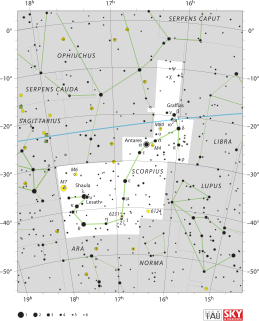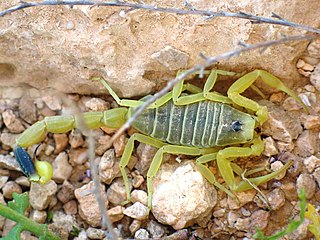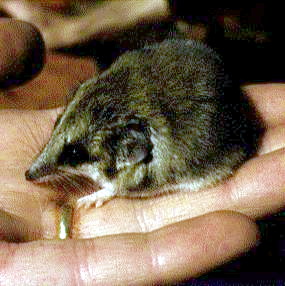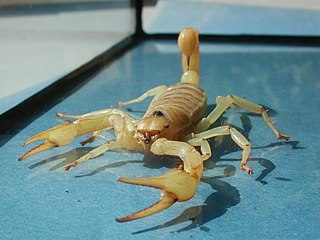
Scorpius is one of the constellations of the zodiac. Its name is Latin for scorpion, and its symbol is . Scorpius is one of the 48 constellations identified by the Greek astronomer Ptolemy in the second century. It is an ancient constellation that pre-dated the Greeks. It lies between Libra to the west and Sagittarius to the east. It is a large constellation located in the southern hemisphere near the center of the Milky Way.

Lasiurus is the genus comprising hairy-tailed bats. The generic name Lasiurus is derived from the Greek lasios (hairy) and oura (tail). It contains some of the most attractive bats (Chiroptera) in the whole continent of North America, including such species as the eastern red bat, L. borealis, and the hoary bat, L. cinereus. They are very robust and long-winged, with fast and strong flight; several species fly during parts of the day, especially when migrating south in autumn. The hoary bat and red bat will often fly in daylight during winter.

The deathstalker is a species of scorpion, a member of the Buthidae family. It is also known as the Palestinian yellow scorpion, Omdurman scorpion, Naqab desert scorpion and by many other colloquial names, which generally originate from the commercial captive trade of the animal. To eliminate confusion, especially important with potentially dangerous species, the scientific name is normally used to refer to them. The name Leiurus quinquestriatus roughly translates into English as "five-striped smooth-tail". Other species of the genus Leiurus are also often referred to as "deathstalkers".

The Arizona bark scorpion is a small light brown scorpion common to the Sonoran Desert in southwest United States and northwestern Mexico. An adult male can reach 8 cm in length (3.14 inches), while a female is slightly smaller, with a maximum length of 7 cm (2.75 inches).

The Yuma Desert Rats were a professional baseball team based in Yuma, Arizona, in the United States.
From the 2005 season to the 2011 season, they were known as the Yuma Scorpions and played their home games at Desert Sun Stadium at the Ray Kroc Complex, former spring training home of the San Diego Padres.

Hadrurus arizonensis, the giant desert hairy scorpion, giant hairy scorpion, or Arizona Desert hairy scorpion, is the largest scorpion in North America, and one of the 8–9 species of Hadrurus in the United States, attaining a length of 14 cm (5.5 in). Its large size allows it to feed easily on other scorpions and a variety of other prey, including lizards and snakes. This species is usually yellow with a dark top and has crab-like pincers. It gets its common names from the brown hairs that cover its body. These hairs help it to detect vibration in the soil. A similar species is Hadrurus spadix

Parabuthus transvaalicus is a species of venomous scorpion from dry parts of southern Africa.
Scorpion I was the first of two rulers of Upper Egypt with that name, during Naqada III. His name may refer to the scorpion goddess Serket, though evidence suggests Serket's rise in popularity to be in the Old Kingdom, bringing doubt to whether Scorpion actually took his name from her. He was one of the first rulers of ancient Egypt.

The lesser hairy-footed dunnart is a small carnivorous Australian marsupial of the family Dasyuridae. It is a widespread and fairly common species, being found in many desert areas of Western Australia, Northern Territory and Queensland. Its foraging strategies have been studied by Haythornthwaite and Dickman.

Paravaejovis (Hoffmannius) spinigerus, commonly known as the Stripe-tailed scorpion or the "devil" scorpion, is very common and widely distributed in Arizona and southwestern New Mexico. This species is one of larger members of the eusthenura group of the genus Hoffmannius, which also includes Hoffmannius coahuilae and H. confusus.

The desert long-eared bat is a species of vesper bat found in North Africa and the Middle East.
Japanese Bug Fights (世界最強虫王決定戦) refers to a more than 58-part video series featuring various kinds of insects, arachnids, and other terrifying creatures battling to the death in a little plastic arena. There are only two bugs to a fight and most fights end with one bug killing their opponent. In some cases, the fights end in a draw if neither bug is able to terminate their opponent.

Route 227 in Israel is a 34-kilometre (21 mi) road in the eastern Negev desert. It starts from an intersection with Route 206 in the northwest and ends in Ir Ovot in the southeast, intersecting with Highway 90. It has one at-grade intersection at 19 km. The original road was laid by British land surveyors in 1927. Prior to 1956, this was the primary route from Beersheba to Eilat.

The black hairy thick-tailed scorpion, Parabuthus villosus, is a species of scorpion from southern Africa, where it ranges from the Northern Cape to Namibia. It is the largest species of the Buthidae, measuring up to 18 cm, and its diet may include lizards and mice. The species is often active at dawn and dusk, but takes refuge by day in a variety of shelters. It resembles Parabuthus transvaalicus, which is more strictly nocturnal, less hairy and with a more easterly distribution.

The fauna of the State of California may be the most diverse in the United States of America. Of the Lower 48 conterminous states, California has the greatest diversity in climate, terrain and geology in general. The state's six life zones are the lower Sonoran (desert); upper Sonoran ; transition ; and the Canadian, Hudsonian, and Arctic zones, comprising California's highest elevations. California’s diverse geography gives rise to dozens of different ecosystems, each of which has its own unique native plants and animals. California is a huge state, the 3rd largest in the U.S., and can range broadly in habitat type.

The fauna of the U.S. State of Nevada is mostly species adapted to desert, temperature extremes and to lack of moisture. With an average annual rainfall of only about 7 inches (180 mm), Nevada is the driest – and has the largest percentage of its total area classified as desert – of all states in the United States. Two-thirds of the state is located within the largest desert on the North American continent, the Great Basin Desert, while the lower one-third is the Mojave Desert.
The Caraboctonidae make up the superfamily Iuroidea. The family was established by Karl Kraepelin in 1905.

Asbolus verrucosus, also known as the desert ironclad beetle or blue death feigning beetle, is a species of darkling beetle native to the deserts of the Southwestern United States, mainly the Sonoran desert. This beetle has been known to feign death when threatened. They are increasingly becoming popular in the pet trade, due to their ease of care, hardiness, and longevity.















